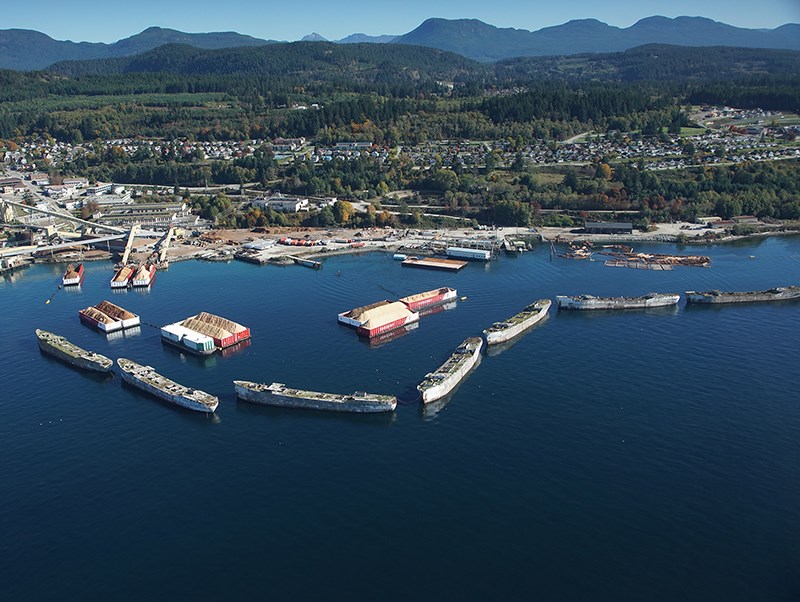Following a public meeting in July to receive input into how City of Powell River should plan for its 230 acres of former industrial land and old golf course property in the Townsite neighbourhood, Townsite Ratepayers Association has completed a report.
According to the report from association co-chairs Kate Dryden and Will Van Delft, the main focus for this neighbourhood review is the area known as the old golf course lands.
In an interview, Van Delft said whatever kind of activity happens on the lands, it needs to be carbon-neutral and greenhouse gas free.
“To some extent, that takes out the potential for resource development, manufacturing or heavy industry,” said Van Delft, adding that maintenance of greenspace is important.
Van Delft said for the ratepayers to more easily visualize what might occur on the Townsite lands, he suggested in the report that it would be great if the city hired an architect to draw out options, put them on paper and show residents what their vision would be for development.
“If we had something tangible to look at, we would be able to give a much better response to any plans that are made,” said Van Delft. “We’d like to see any development consistent with the unique character of Townsite.”
He said material for the report was gleaned from meetings the ratepayers association attended. He said he put together a draft document from the discussions and passed a draft to the membership for feedback. He made a few changes as suggested and finalized the document.
The report stated that once upon a time, as stated in previous sustainable official community plan (SOCP) documents, the Catalyst mill was the main industrial complex of Powell River.
“Although it still operates in the local economy, it is definitely not significant,” the report stated. “The mill, which once operated with a workforce of over 2,500 employees, now is a shadow of its former self, with only one of 11 original paper machines operating, and only around 250 employees on payroll.
“This is no longer a mill town. In the timeframe of this SOCP, it is possible to plan for the potential closure of this mill and to anticipate the greening of our economy to respond to the ongoing climate crisis.”
Climate consideration
Heat events the community experienced this summer is a cause for alarm and some serious consideration for future climate events, according to the report.
“We have been warned ad nauseam about our lack of attention to the seriousness of climate change,” the report stated. “If we are to seriously plan for the next decade, we need to begin addressing our climate crisis. Our challenge is to begin to create a realistic and sustainable community plan.”
To begin, there needs to be a plan to reduce the carbon footprint, plan for zero emission in all activities (industrial, residential, economic and recreational) and eliminate or seriously reduce greenhouse gas emissions, the report stated.
“The worst thing we can do is develop these lands in piecemeal fashion, as we are currently doing. We are in danger of losing our ability to make visionary long-term plans. Perhaps a contract for a community symposium would be helpful in encouraging us to move forward in a progressive way.
“To prepare for appropriate future use of the golf course lands, the current employment zoning designation is not the appropriate classification zoning for the future. A conditional mixed-use designation is better suited to respond to future developments. We imagine a development of integrated zones for greenspace, residential and business, coordinating in a new circular economy within the context of a general Townsite renewal.”
Polluting industrial activity will no longer be considered, the report stated, and a zero-emission green economy will be more suitable for small businesses rather than large infrastructure-dependent manufacturing businesses.
“Business development needs to be focused on small business and done in conjunction with our Townsite business zone.”
Enterprises such as the consolidated wastewater treatment plant will need to alter the planned output from secondary to tertiary treatment; institutional buildings should not be permitted in this area; and the Brooks Secondary School complex needs to be confined to its current footprint, according to the report.
Because of the need for more boat storage spaces, a marina could be built, with conditions for public access and walkways; other appropriate businesses should be water-based, such as scuba diving and kayak sales and storage, the report stated.
“Consideration needs to be given for potential increase in sea levels of up to two metres,” the report stated. “A bikeway built on top of the current contaminated shoreline would forego expensive environmental cleanup costs.
“Greenspace development would include cycling and walking trails along the shoreline and a continuation of the Willingdon Beach trail to connect with the Townsite business centre.”
New residential development needs to be based on net-zero building codes such as the BC energy step code, the report stated. Townhouses and condominiums could be developed in modules to capture ocean views of the Salish Sea.
“We need to conceptualize and capture the anticipated changes in the way we move. Truck and car transport will be significantly altered. We need to imagine a townhouse or condominium complex that does not require an extensive road network. Development of an extensive network of trails and bicycle paths along with a major community investment into signage is mandatory to encourage citizens to make important decisions.”




